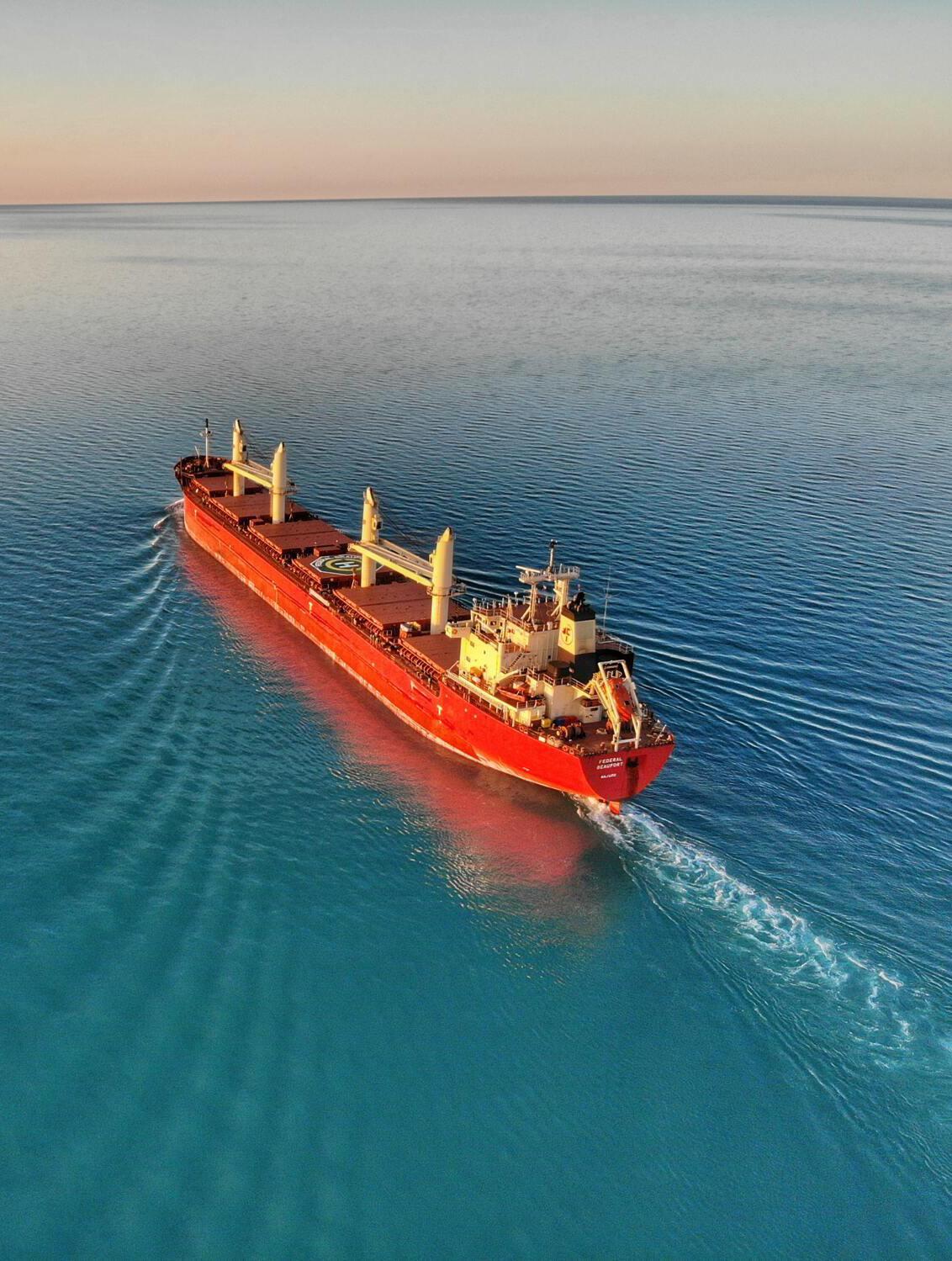







Diversity is a topic of utmost importance to the maritime industry; as it is known to produce better results. Many shipping companies have found that having women in their workforce and even more so in positions of responsibility has produced a positive result. “Women have now found and secured their position in the shipping sector, at least on shore, since the role of women in maritime has evolved significantly over the years. The complete findings of the survey on the gender based discrimination against women, have proved that the full equality on ships are no way off and the difficulties women face and still encounter on vessels are vast. We still have a lot to do,” said Ms Elpi Petraki, President, Women’s International Shipping & Trading Association (WISTA) International.
She was speaking at the Maritime SheEO conference titled – Changing Leadership Paradigms that was held on November, 16th at the opulent Taj Santacruz in Mumbai.
I was shocked when I heard the findings of the survey when it was presented at the WISTA International Conference in Geneva just a couple of weeks ago. I realized that this research could be a new and more loud wake up call to the maritime industry worldwide. We need to look
at how to change behaviours and attitudes onboard. We have to work together to find ways to solve this problem.
WISTA is passionate about driving change. And appreciates initiatives such as the Maritime SheEO conference and the Diversity Guide. I’m delighted to officially announced the formal partnership between WISTA International and Maritime SheEO. We signed a Memorandum of Understanding (MoU) at WISTA International Annual General Meeting on 26 October in Geneva, Switzerland. Under this new MoU is the second Maritime SheEO Leadership Accelerator Programme (LEAP). An excellent initiative that is helping women across the maritime industry to develop leadership skills and take the next step in their careers. I would like to congratulate Ms Sanjam Gupta as this is her brainchild. We will always be there to support your efforts.
Creating a sustainable maritime industry and work
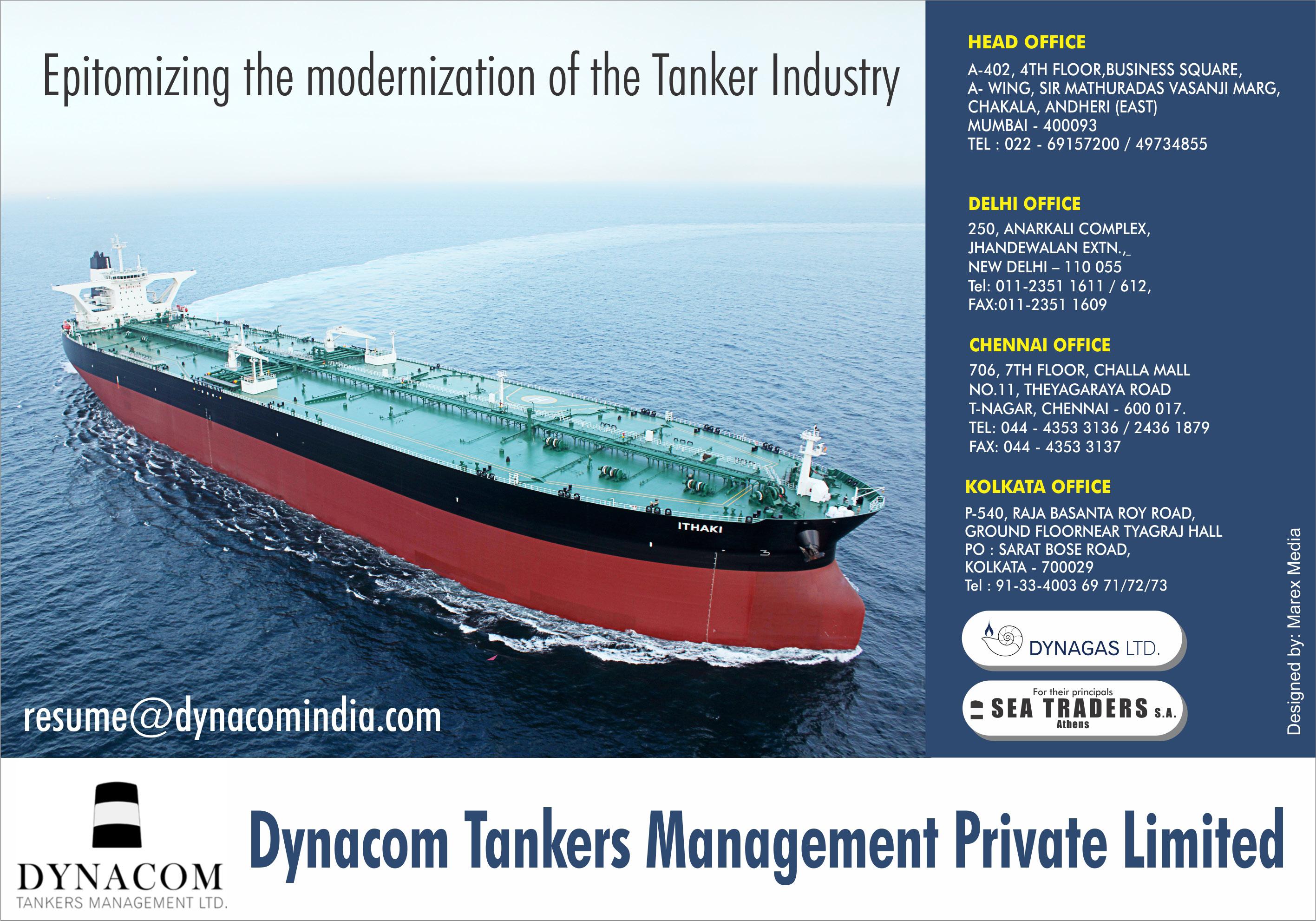
environment that has new equal opportunities for all is directly related to diversity and inclusiveness. I strongly believe all business leaders should strive to make their companies as inclusive and free of discrimination as possible.
If we have people from various backgrounds in our companies and teams, then we will offer equal opportunities to everyone and we will hire new employees without regards to their gender, religion or nationality. We will provide opportunities for development in order to achieve our business goals together. We have a responsibility to raise awareness on the beliefs and the benefits of diversity, to break down barriers for career progression and change traditional mind-sets to create a right environment for everyone.
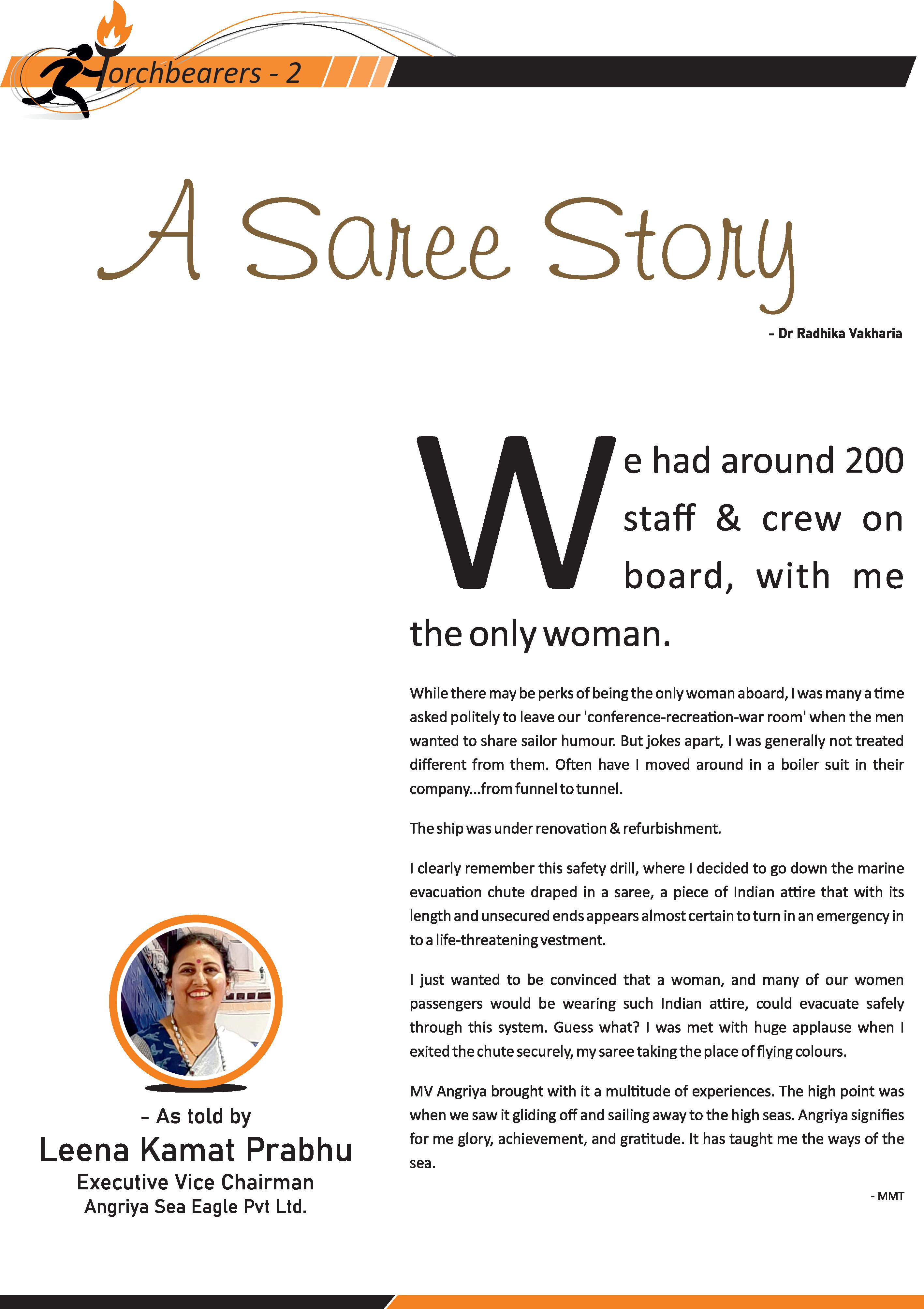
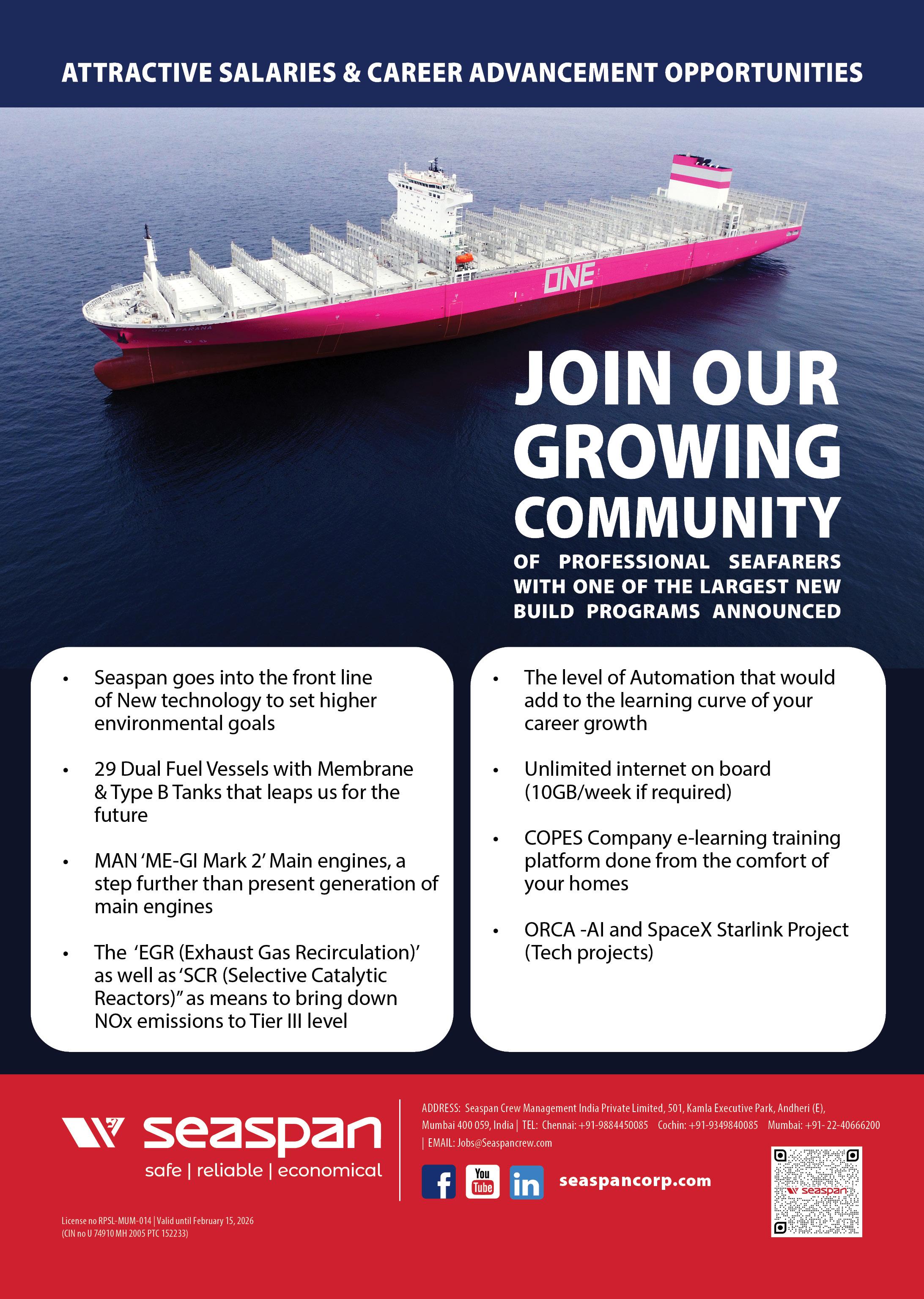

Maritime sector holds a significant position in global economy and maritime transport accounts for around 90% of worldwide trade. Historically the economic prosperity of nations has been linked to trade through the sea. Hence, we can say that oceans are the “superhighway,” that links economies together and facilitating exchange of value, be it food grains, manufactured products natural resources among other goods of necessity. Hence maritime transport influences lot of industries, directly or indirectly impacting development of the maritime dependent sectors, which in turn fosters economic growth and job creation.
In the past few years, the shipping industry has experienced a massive expansion in demand reflecting the growth in volume of seaborne trade with a CAGR of 2.5 %. This has directly resulted in more sea men
at work putting a tremendous pressure on seafarers’ work life balance. Nearly all things sold world-wide are transported through ships, which need skilled seafarers. Without “Seafarers” there can be “NO Shipping”. Needless to say, the word would come to a halt and the people would be devoid of their basic necessities if the ships and seafarers didn’t work. It is because of these seafarers’ businesses around the world continue to thrive. The seafarers are the unsung heroes and are probably the least understood for their tremendous contribution they make to the industry. While people on land work in their extremely cozy offices, seafarers work through toughest conditions to ensure that businesses around the world do not stop.
Are they really cared for?
• Are the shipping companies equipped to adhere to the need of their seafarers?
• Is there sound HR policy in place to ensure their aspirations are met?
• Do companies really care for their mental health?
• Is there an effective career development plan for them when they plan to switch ashore?
• Is there any policy in place which takes care of their family, if anything goes wrong with them during their leave period?
The list can go endless….
Seafarers are a unique breed of workers, often more resilient and robust than their standard nine-to-five counterparts. They spend months at sea, separated from their dear ones, and work selflessly. People’s lives and economies would not be the same in the absence of the activities carried out in seas and without the seafarers. Hence, the seafarer deserves a better work life balance.
The companies should consider the following…

The companies need to take utmost care for the sacrifices a seafarer makes. Their needs to be assurance of physical, emotional, financial support and job security so seafarers can work stress free. Mere hiring of people is not enough, companies must train them for the purpose. There need to be a proper career development system to achieve a balance between individual career needs and organizational workforce requirements. To recruit and retain best talent, organizations not only need to be high performing but also be seen to be credible with integrity and value system. Hence organizations which adopt the human resources as ‘’partners in progress’ policy demonstrating a distinct HR philosophy characterized by employment security, company flexibility, sharing of financial success with the workforce will survive. This necessitates that shipping companies have a sound human resource planning for creating future workforce both for sea and at shore.
Managing people is about working with your workforce on a partnership basis to achieve the strategic goals of the organization. There need to be proper training and development program for the seafarer. Training must be viewed as an important investment for firms’ future success and not as a liability. It is important to enhance interpersonal relationship between people on board as well on shore to ensure that all jobs are done smoothly and safely. Teamwork is important as it enables shared responsibilities. When you work together and succeed together, you feel good and you foster a better working relationship with your colleagues.
Effective training in mental health awareness for seafarers and shore based maritime professionals working with seafarers can have a very positive impact on seafarers’ mental wellbeing. There need to be a Proper Training that can equip seafarers with the skills needed to effectively respond to a concern on board or within their company. Training should also emphasize about the importance of looking after one’s own mental health during a voyage.
The employees of any organisation are the driving force behind its success and an HR has an important role to play to manage the human capital. Today, employees are seeking a reliable and supportive environment during uncertain times. Hence, companies need to focus on building strong leadership and a sense of trust among the current workforce and potential employees. A strategic HR provides a roadmap for solving an organization’s biggest challenges with people-centric solutions.
This approach requires HR input during policy creation, talent management, compensation, succession planning, corporate culture and employee wellbeing. For a solid productivity plan to work, companies should be focusing on accomplishing future goals with strategies that increase employees’ overall productivity. HR can make employees happier and more productive by providing an enjoyable work environment that help retain talent. Prosperity from sea have been an historic fact. However, to realise its potentiality in the new age of technology, an enabling environment need to be created. This can happen through effective HR policies and linking the aspirations of seafarers to those policies.
At Nevoxel Consulting, we strive to engage as partners to maritime organisation and seafarers alike through enacting the role of creating inquisitiveness and interest in the organisation for seafarers, while identifying the best possible candidate fit for the organisation. Our approach is consultative. We act as career – coaches to seafarers to provide market situations including types of jobs, skills in demand, and career progression prior to co-creating the most appropriate career roadmap for the seafarer along with action plans. This career enabler role is aimed at developing a healthy professional relationship with seafarers and mapping their interest and fitment to the role entails a consultative approach to strategic workforce management to the clients.


DB Schenker extends its portfolio of climatefriendlier logistics solutions by opening the next chapter of greener transport in air freight. With immediate effect, customers can choose Sustainable Aviation Fuel (SAF) for their air transport to anywhere in the world and independent of the type of aircraft or airline used. Via virtual allocation of the biofuel, it is possible to avoid up to 100 percent of CO2 emissions.
Jochen Thewes, CEO of DB Schenker: “We are very proud of the game-changing pioneer project we started with our trusted partner Lufthansa Cargo. Today, we take the next step by starting a global green air cargo network. We have purchased massive volumes of biofuel to push the decarbonization of our industry. Customers of DB
Schenker can now virtually book SAF on all trade lanes to thousands of airports. This new flexibility is a success factor and good for the climate. Every ton of biofuel counts.”
Thorsten Meincke, Global Board Member for Air & Ocean Freight at DB Schenker: “Reducing the carbon footprint in supply chains is possible not only in a far-distanced future but already today. Yes, sustainability comes with a price. But now the choice is available: No DB Schenker customer needs to use traditional kerosene for their air freight anymore. We hope that this message will give further momentum towards sustainability in aviation. Customers who have tested or are already regularly using our SAF offer are very satisfied.”
SAF is a well-tested alternative fuel produced from renewable waste and residue raw materials such as used frying oil. The CO2 released during combustion in the engine is only the CO2 removed from the atmosphere during the photosynthesis phase of the plants employed to produce the oils SAF is refined from. DB Schenker only uses biofuel which is certified palm oil free. Currently, SAF is 3-5 times more expensive than regular fossil-based fuel.
For their ESG reporting, customers deciding to pay the premium for virtual allocation of SAF for an air freight shipment receive certification for the exact amount of greenhouse gases avoided. While the actual physical insertion of SAF might occur on different flights, the climate is protected as the exact CO2 emissions of a flight or shipment with conventional kerosene are avoided. This process is called a virtual application and can also be

exercised for upstream emissions originating from the production and transport of the biofuel itself.

The new global offer complements DB Schenker’s unique weekly full charter route between Germany and China, launched in spring 2021 and still the only regular air cargo flight in the world to be fully covered by SAF. Over 150 round-trip flights with Lufthansa Cargo have already avoided more than 40,000 tons of CO2e. Individual SAF agreements with further airline partners, for example a recent purchase of SAF credits at Singapore Airlines, will continue as well.

India’s Maritime Sector has a glorious history and has played a very important role in India’s economic growth. “In the last 8 years under the visionary leadership of Hon’ble Prime Minister Shri Narendra Modiji, we have focused on port-led development which includes expanding port capacities and making the existing systems even more efficient. Waterways are being harnessed to ensure Indian products get access to new markets. Our maritime sector has scaled new heights and contributed to boosting trade and commercial activities. The government has focused on modernisation, digitization, rationalisation of laws, simplification of procedures, PPP participation, etc. in the Port sector which was essential for economic

growth and building of an “Aatmanirbhar Bharat,” expressed the Honourable Union Minister of Ports, Shipping & Waterways and Ministry of Ayush, Mr Sarbananda Sonowal. He was speaking on the second day at an enriching conference as the Chief Guest.

The Institute of Marine Engineers (India) Mumbai Branch along with its Navi Mumbai & Gujarat Chapter had organised its flagship event “INMARCO 2022” from 17th to 19th November at the posh Hotel Sahara Star in Mumbai. This year’s theme is Evolving Maritime World for Greener & Sustainable Future.
Also present were Mr Rajeev Nayyer, Chairman, INMARCO 2022; Mr Vijendra K Jain, President, IME(I);
Mr Amitabh Kumar, IRS, Director General of Shipping; Dr (Mr) Sanjeev Ranjan, Secretary, Ministry of Ports, Shipping & Waterways; and Mr David Birwadkar, Convener, INMARCO 2022.
He mentioned that the Maritime Sector’s contribution towards achievement of India’s US Dollar 400 Billion export target for the years 2021-22 well ahead of schedule, was phenomenal and was a result of these radical changes.
On digitalisation, he articulated that we are constantly modernizing and digitizing our infrastructure to compete with the most modern maritime nations of the world.
Mr Sonowal highlighted that the Government of India has started National Hydrogen Mission with an outlay of Rs. 30,000 Crores between 2022-2023 and 20292030 with an ambition to start producing at-least 5 million metric tonnes annually of Green Hydrogen by 2030.
“I am happy to note that in line with National Biofuel Policy to reduce interdependence on fossil fuels, we have also permitted ships to operate with biofuels as per Maritime India Vision 2030 roadmap towards greening Indian ships and ports. The Ministry for Ports, Shipping and Waterways intends to increase the share of renewable energy to 60% of the total power demand of each of its major ports from a present share of less than 10%.”

“I am glad to declare here that MoPSW has now taken a decision to establish India’s first National Centre of Excellence for Green Port & Shipping (NCoEGPS) which is a big initiative to transform its Ports and Shipping to Green,” he continued.
Elaborating on CES, he pointed out that this Centre of Excellence will help on policy and regulatory support to the Ministry of Ports, Shipping and Waterways for developing regulatory framework and alternate technology adoption roadmap for Green Shipping to foster carbon neutrality and circular economy (CE) in shipping sector in India.
And he thanked Deendayal Port, Kandla Port, Paradip Port, V.O.Chidambaranar Port Authority & Cochin Shipyard Limited, for acting as promoting organisations for this Centre of Excellence and for providing the necessary initial funding.
He concluded, “Our leading shipyard, Cochin Shipyard Ltd (CSL) is presently constructing a fleet of 23 Nos. Battery Electric-Diesel Hybrid passenger ferries each to carry upto 100 passengers, to be deployed in the inland waterways of Kochi. This initiative by the Kochi Water Metro will radically alter the Urban Mobility ecosystem in Kochi. I understand that this is the largest amongst such Green projects in the water transport segment globally.”
As we all know Bharat inherit a very rich tradition in maritime trade and in our history books we have read about the trading centres of ancient India from where ancient seafarers sought merchandise in exchange for even gold. A log book of sea trade over the Red sea discovered and named as periplus of the erythraean sea recorded by ancient Greco Roman traders with Bharat, mentions among others, various trading ports over the Indian peninsular coasts, from where good where exchanged. The said manuscript also mentions about Hippalus the Great sailor who came to know from the Arabs about the monsoonal winds which helped ship sailed faster to the Indian coast.
One significant port among them was the port of Musiris near the present Major Port of Cochin, near a place called kodungalore the then ancient capital of the Chera rulers. Roman traders took spices and ivory from here for which they had to pay in bars of gold and it is recorded that a roman thinker and statesman Gaius Plinius Secundus popularly known as Pliny warned the King of Rome to regulate trade with Bharat to prevent the Roman economy from collapsing. The major trading ports mentioned in the manuscript are barygaza (modern bharuch in Gujarat), sourashtra, indus and gangetic riverine belts, naura and tyndis (Malabar region), musiris (cochin), limyrike (coromandal area) among many. While this book is silent on the eastern coast it is from ptolemys and Alexandrian scholar Claudius Ptolemaeusthat’s writings on geography in the early centuries of the Christian era we also come to know about the trade from the ports of Bay of Bengal.
(Satavana Coin circa 1 AD showing Indian Ship)


Prior to the advent of metal based ancient

maritime economy, ancient civilisations and settlements around the sub continental river basins traded on stones, beads, furniture, honey and animals/birds. The excavations in arikamedu in Pondicherry and Lothal in Gujarat proves about bead making factories and trading at these port centres. The most recent excavations at kiladi and adichennalur in Tamilnadu links to a possible maritime trade between these centres to the Narmada basin. Among all the identified pre ancient entries of trade lothal attains significance as the FIRST PORT from all available evidence.
(Lothal dockyard 2500 BC)
As we know today, maritime trade is directly linked to the economy of the nation and ancient Bharat have vividly recorded the economic aspects of maritime trade. With Colonies in South East Asia, Malayan peninsula, and in Java and Sumantra, Kings and traders in India recorded tax and transactions which today gives us a clear picture of our maritime economic thinking. In addition to the famous arthashastra of kautilya, khemendra’s bodhistava kalpalata written during the mauryan period, Jatakamala of aryasura, a budhist work giving details of navigation skills bhaveru Jataka on export of peacocks to Babylon, boudhyayana’s dharma shastras describing taxes on ships , vrihat sand yajnvalkya samhita detailing about the sea faring castes are just few among the many. Needless to say mention is also to be made about the efforts done the vanarasena in the Ramayana to reach lanka
and the travels of nakula through the sea route in the Mahabharata. The much discussed movie of Ponniyin Selvan describes the exploits of the Chola kings in the Indian Ocean is also a good mention to prove this legacy
The legacy of the ancient period was continued in the medieval times and sadly the history of Bharat in the modern age is also about being defeated and colonised by seafarers.

Setting up maritime complexes have been hence become a necessity for a country like Bharat with such an extensive coastline. Such heritage complexes will ensure that our maritime legacy is kept intact benefiting for the future generation, the first initiative in this direction was done by Government of Kerala in developing the musiris heritage project. An effort has been made in conserving the historic heritage buildings like synagogues and old palaces. However, these were all related to the mediaeval period artifices but there is a lack of a detailed theme park and tourism complex, which showcases the historic lineage.
It is in this direction that the ministry of Port shipping and waterways have now taken the initiative to showcase ancient port cities as National Maritime Heritage complexes (NMHC) and Lothal in Gujarat have been chosen to be developed initially. For the implantation of this project an inter-ministerial MoU was signed between Ministry of Ports Shipping and Water ways and Ministry of Tourism and Culture creating synergy between the two ministries in executing this historic project.
NMHC will be first of its kind in the country comprising of maritime museum, light house museum, maritime theme park, amusement parks centers, etc., which will leverage modern technology to showcase maritime history and will be an international/national tourist destination. NMHC will consolidate all diverse and vibrant artefacts from ancient to modern times and provide access to the public and to spread awareness. An edutainment approach using the latest technology will be adopted for the development of NMHC Project.

Showcased to preserve India’s rich and diverse Maritime Heritage her history and archaeological importance the project is bound to be an internationally acclaimed tourism destination. Located nearly 75 Kms away from Ahmedabad near Saragwala village, the complex will integrate the World Heritage City of Ahmedabad into the world map of maritime tourist destinations attracting tourists from India and abroad. A maritime heritage complex at such a crucial location will befit the historical importance of Lothal and will help it become an area of extraordinary and unparalleled maritime heritage which is already a UNESCO world heritage site. NMHC is being developed as a major tourist destination enabling visitors to indulge in a holistic Maritime Experience involving History, Education, Entertainment and Leisure and will be the first in the country to showcase India’s Maritime Prowess over the past 3500 years.
The 375 Acre Master Plan of NMHC is guided by Harappan Town planning Principles. The Citadel, situated at the highest elevated point of the site houses the most important buildings. The Middle Town & Lower Town accommodates for the remaining parts of the town based on hierarchy of uses. The Middle Town includes the Central Bagicha & Maritime Institute. The Lower Town consists of Recreational Theme Parks, Eco resorts and Hotels / Museotel. The project is being developed in a phase wise manner. Certain facilities are proposed to be undertaken in PPP mode.
Concluding this we need to accept that for a sub continental nation like Bharat, with currently over 200 ports, it is imperative that we document and showcase our maritime legacy. The Indian maritime community worldwide should ensure that our past knowledge and experience is widely reinforced as our nation is poised to be the Viswa Guru.
RNI: MAHENG/2013/50159
Published by Marex Media Pvt Ltd C-209, Morya House, New Link Road, Andheri West, Mumbai 400058 Email: info@marexmedia.com
Printed by Young Graphics Printed at Young Graphics, 208 Shankala Industrial Premises, Gogatewadi, Goregaon(E), Mumbai-400 063

All advertisements in this magazine are placed with no liability accepted by the publisher for the material content therein. No responsibility is accepted by the publisher for omission or error or non-insertion of any advertisements. All advertisements and material in this magazine are subjected to approval by the publisher and are not necessary the opinion of the publisher. No liability is accepted for advertisements that are placed or any information that might be criminally connected. All information is checked to the best of our knowledge and is reliant upon the material submitted not being in contravention of all relevant laws and regulations and within the provisions of the Trade Practices Act.
Maritime Matrix Today will not be responsible for the views expressed by contributors in their personal capacity. All rights reserved. Reproduction in part or whole without the permission of the Editor is prohibited.
Readers are recommended
To make appropriate enquiries before sending money, incurring expenses or entering into any commitment in relation to any advertisement published in this publication. Maritime Matrix Today does not vouch for any claims made by the Advertisers of Products and Services. The Printer, Publisher, Editor and Owner of Maritime Matrix Today shall not be held liable for any consequences, in the event such claims are not honoured by the Advertisers.



 Delphine Estibeiro Editorial Coordinator
Shirish Kirtane Sr Graphic Designer
Jagdamba Pandey Advertising Coordinator
Delphine Estibeiro Editorial Coordinator
Shirish Kirtane Sr Graphic Designer
Jagdamba Pandey Advertising Coordinator
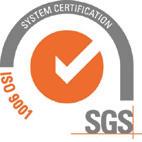

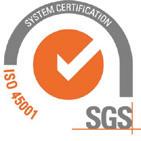
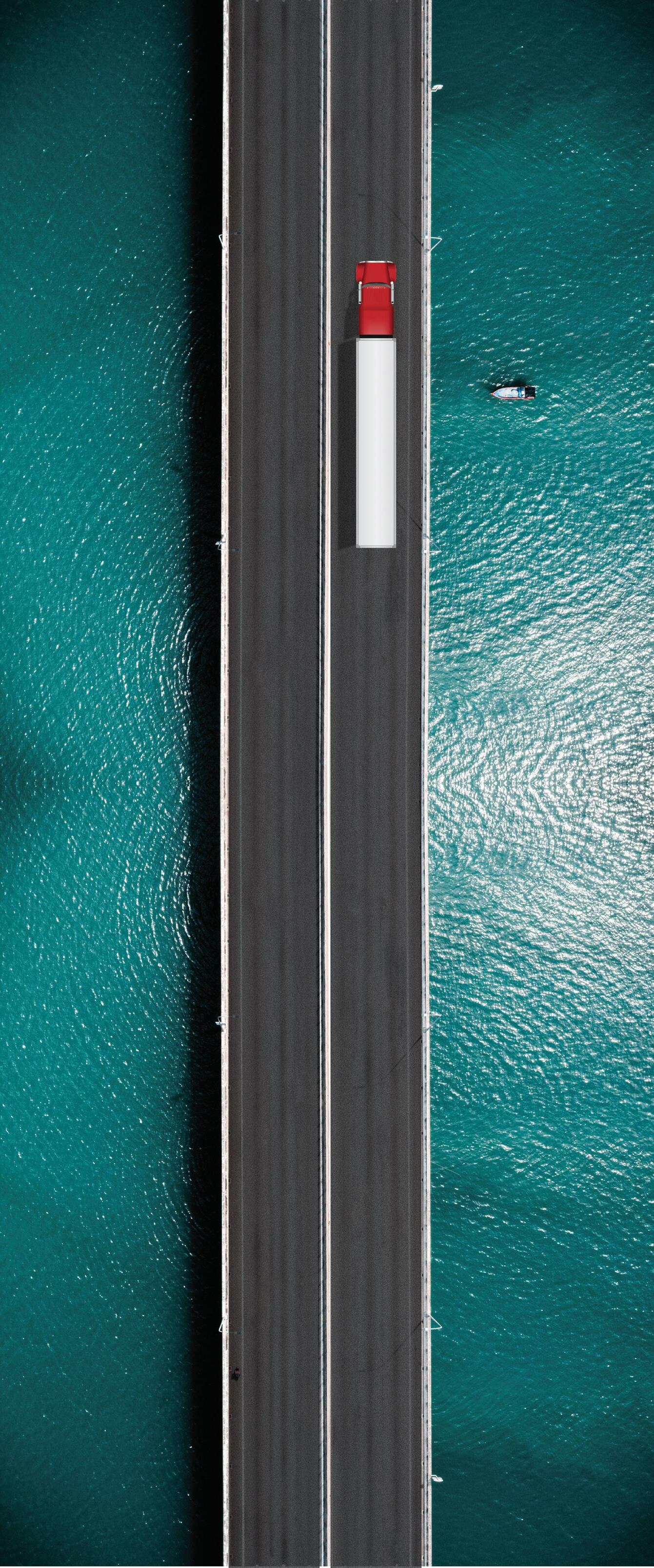
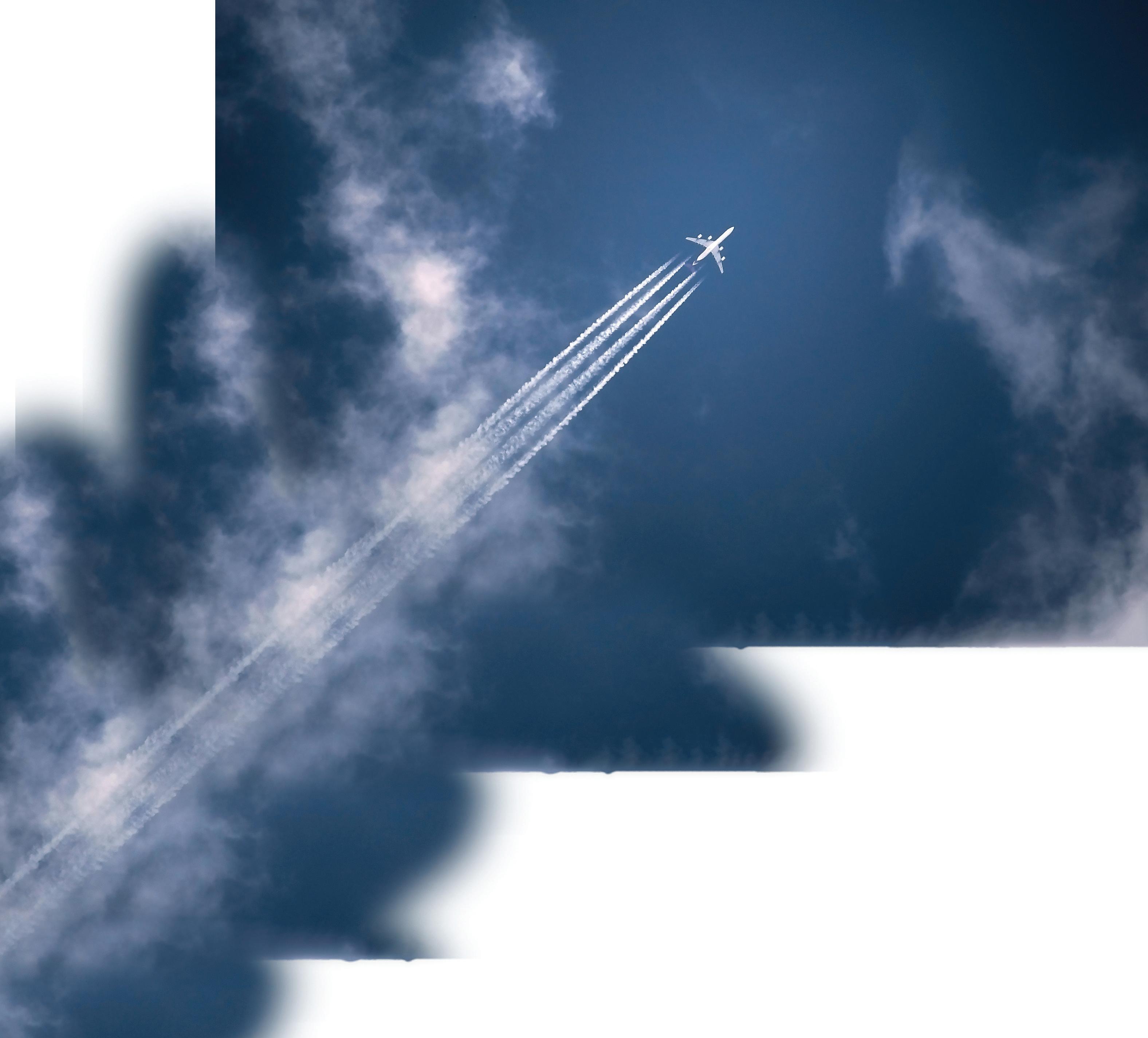

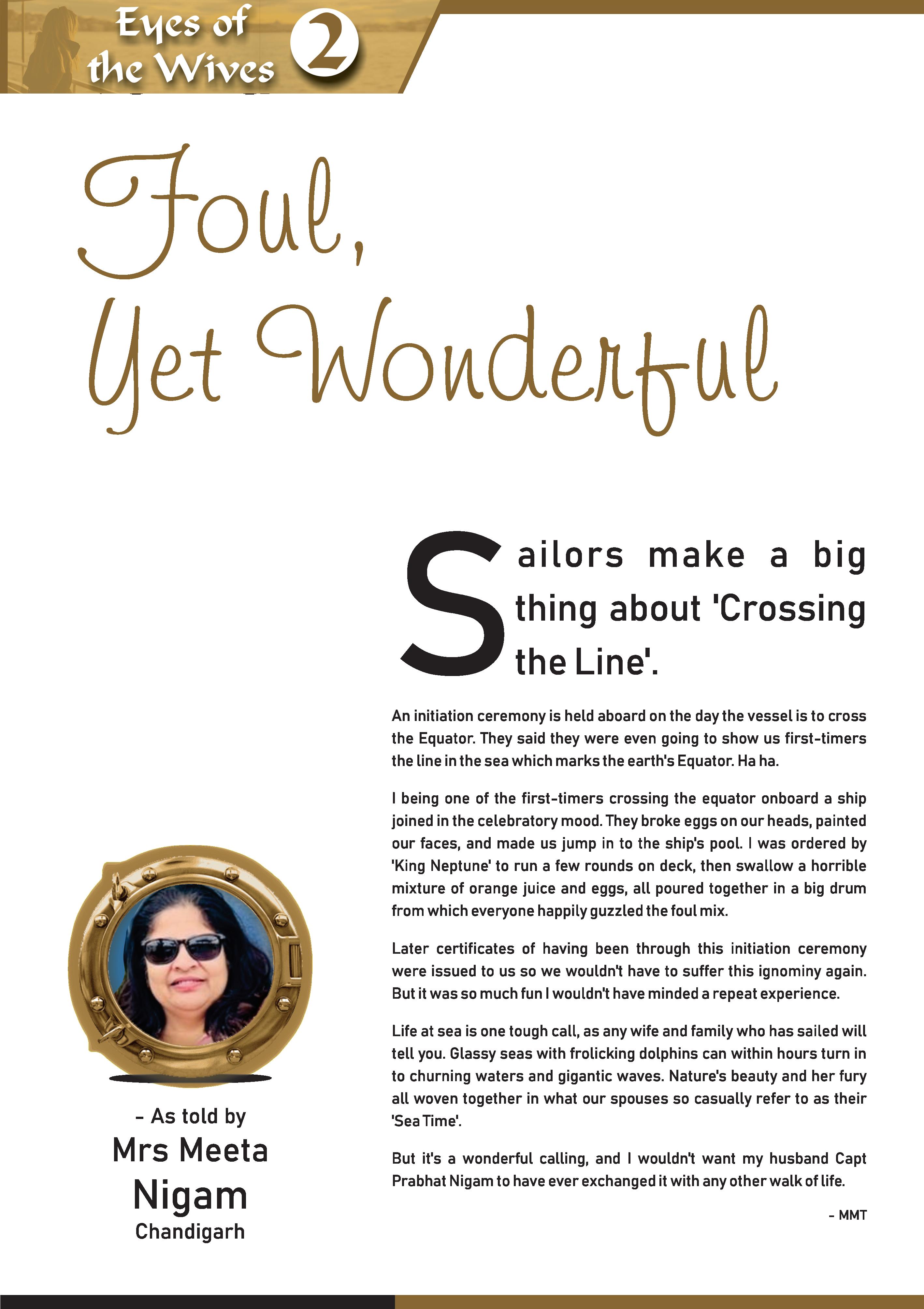
Aproud award winner of TOP 20 under 40 maritime professionals, a MBA graduate in Operations & Finance, a proud Stanford Alumni, a Master Mariner & an ESG enthusiast with over two decades of experience in Maritime Business, Commercial Operations, Port/Tanker Terminals, Quality Management, Data Analytics, Digital Transformation, Maritime Sustainability, Strategic Advisory & IOT/Digital Products, along with extensive sailing experience; Capt Mohit Sabharwal dons multiple hats and has paved the way for change in the industry. Capt Sabharwal believes in learning, engaging, accelerating & disrupting organizations and industries. What an illustrious career of a seafarer!
In an exclusive interview for Marex Media, Ms Neetu Jaiswal, Founder, Nevoxel Consulting in tete-a-tete with Capt Sabharwal shed light on innovation, and further paving new growth opportunities for other industry professionals.

You have a diverse background, and doing lots of interesting things besides your seafaring career, could you share about your career and how it has been evolved so far?
I sailed for around 15 years mainly on petroleum tankers (VLCCs), after which, had a brief stint was with Reliance Ports & Terminals as a Marine Pilot and Port Captain, which led me to Maersk in their commercial operations.
Three years back I started my start-up journey where I got this opportunity to join and head the operations in one of the start-up backed by MISC & BCG (Boston Consulting Group). Presently, I am deeply immersed in this ecosystem in many forms and shapes, where now I am in the Sales & BD role for three start-ups (3 products) which use to be three different companies back in time and now under the umbrella of Magellan X. Beside this I am also involved with few other businesses as a Mentor, Board member, Investor and Strategic advisor with the intention to contribute to the businesses.
What is the most challenging part of being a seafarer and why do seafarers quit sailing midway before reaching the senior rank? What triggered you to quit sailing?
Different people have different priorities, it’s difficult to point a single reason. But at large, staying away from family and personal commitments can be one of the reason, especially when seafarers quit sailing mid-way of their career. Other factors which cannot be ignored, such as sailing environment, mental wellbeing, individuals own aspirations & risk and reward ratio, which again vary from person to person.
I quit sailing mainly because of my aspirations and the fact that I wanted to do so much more. Family was one of the reason (after having two kids) but that was never a primary reason. The main reason was, to come ashore after commanding the ships, and utilise my experience in a way where I can learn and same time contribute to the maritime trade, from the other side. I am also curious by nature and eager to learn new things and this curiosity pushed me to do something more, as most of the times I use to feel that my capabilities and potential is underutilise on board ships.
Having an illustrious career in shipping, any specific reason to opt for a Non-shipping MBA? How has it helped you in your career?
Being a keen learner, I always look forward to hop on to those opportunities where there is a chance to learn and upgrade myself, so that I am better armed to apply those skills to real time applications.
I was very clear about my post-graduation studies (MBA) to be non-maritime based, due to my strong desire to connect with other industries, professionals and specialists, so that I can understand the dynamics there and then bring it back to the maritime industry those practices which do not exists here or those which has huge potential in the business or industry if implemented.

What made you choose a tech start-up rather than choosing any other domain in maritime?
In 2019, I joined a tech start-up Chord X which provides measuring and analysing fleet’s machinery parameters,
in real-time & provides emission monitoring & fuel consumption of assets through data from source (from the machinery itself). There were two more start-ups, which were incubated by the same investors. Those were Sol-X (addressing Human Factors in safety through IIoT) and SCNX (Inventory Optimisation). All the three companies were brought under one umbrella company, as three products, and the company Magellan X is now a global leader in ESG tech who develops and invests in environmental, social and governance (ESG) technologies.
Reason for choosing the start-up was mainly due to my initial thought of doing multiple things at the same time. A start-up gives you an opportunity, where you start with almost nothing and build each day, along with other diverse group of people & competencies, which contributes to your next level of learning at the same time. Moreover, it was something related to the transformation of the entire maritime industry in coming decades, and after serving for so long here, my thoughts were how could I contribute towards the face change of shipping business.
Currently, you are involved with multiple start-ups both within and outside the Maritime industry. Please share your contribution as an Advisory board, Mentor, and Investor; and your management style?
Beside Magellan X, I have been involved with multiple
start-ups, founders, accelerator programs, venture capitalist firms with a sole intention to contribute to the ecosystem, sharing expertise & experience, through mentoring & investing in high potential businesses with an aim for positive impact on our communities & environment. Invested in few dozens of them, associated as a Mentor to guide them in the business management, people management aspects and how they can achieve operational excellence in their offerings and operations.
For instance, in a 3D Animation Studio, I am helping them to grow and scale their business. Few other examples are companies such as Charismight (Addressing the critical Human element), Navguide Solutions (Creating innovative micro-learning tools that improve ship’s performance organically), Hydro wind Energy (Leading, accelerating & defining the transition to renewables).

My management style is mainly collaborative and people oriented. I believe in creating high potential teams and then driving the show with people at front
collaborating together with internal as well as external stakeholders.
You are known for your curiosity, has this curious nature benefitted you both professionally and personally? What is the most courageous step that you have taken in your life?
Yes, my curiosity has inculcated a default habit of asking series of questions of anything coming my way (personal or professional). This helps me establish a connect, decide and plan ahead a more meaningful path.
The most courageous thing
I have ever done! Beside turning a loaded VLCC 180 degree, carrying 2 million barrels of crude oil in tightly packed Fujairah anchorage (to move out for sailing) and that too on my first day of taking command.
I have taken few courageous steps in my investments in the last few years, where I have invested in businesses which are supposed to be the riskiest. Every time I tend to get comfortable in my role. My next action is to make myself uncomfortable and push myself for next challenge, which is something not easy. I think, especially when you have host of personal commitments and a family to serve.
As technology is rapidly changing, what key competencies are required by a seafarer at a Management and Operational level?
Yes, this is an era of digital transformation for the industry. With the onset of technological advancement, it will also bring new skills and competencies whereby shipping will need to shift towards essential skills for the future including general IT systems and networking, system-specific trainings, better academic and soft skills, multidiscipline seafarers, and cyber security.
Apart from investing in skills for those who struggle with a transition to a more automation-heavy industry, there will be an ongoing need to invest in softer skills that impact the overall wellbeing of those at sea in the near future. Soft skills such as emotional intelligence,
communication and critical thinking, have an incredibly important role in the future of seafaring. Today’s seafarers are self-selecting i.e. anyone who can pass the exams and has no disqualifying medical conditions can go to sea. In the future hi-tech world of small crews, it is possible that interpersonal skills will be as important as technical skills.
With the move to remote and autonomous technologies, are there new career avenue opening up for seafarers?
Definitely! The shipping environment is changing rapidly due to digitalization. Taking this into consideration, it is only natural for the work and the needs of the future seafarers to be different than today. According to the report by Inmarsat, “A fair future for seafarers,” the seafarer of 2050 will likely work in a much smaller crew, but have greater interaction and engagement with teams of people ashore. As automation takes over the dull, dirty and dangerous tasks, from watchkeeping to tank inspections, seafarers will be free to focus on the safer and more interesting tasks. In the future, going to sea is more likely to be a stepping-stone to a career ashore. Those that do may find their skills are more in demand when they are ready to transition into shore-based roles such as shore control stations.
Has life at sea really changed? Do you think people are losing interest in sailing as compared with earlier days? And why?
Yes, a lot has changed. On a brighter side from minimal connectivity or communication to almost 24X7 connectivity this is definitely something which has changed for good. Other changes that has evolved is faster turnaround of ships, increased commercial pressure, lot of administrative tasks and paperwork and cost saving in different aspects. Recent activities such as Piracy and Covid have further lowered seafarer’s moral which contributes to both mental and physical wellbeing. Less shore leaves opportunities (mainly due to covid), health issues which goes back to the diet of individuals are some of the other reasons why people are losing interest and tend to leave sailing career earlier than before. Poor management of manpower on board ships resulting in increase in work load is another reason which is commonly reported across the community and making several seafarers quit sea jobs early.
Is there enough awareness on shore-based jobs?
8 years ago the awareness was not much, it’s changing now, it is increasing. Today, we have many recruiting firms that specialise in maritime recruitment. Slowly and gradually seafarers are finding it easier to at least, be aware of the opportunities as compared to past years. Having said that, much more work needs to be done if we compare with other industries. It’s not only about publishing the shore job or opportunity which most of the recruiting companies are into. It’s much more than that, when it comes to understanding the shore life, the dynamics involved in roles and responsibilities, the
deliverables linked with each role, planning the financials when ashore, and managing liabilities accordingly with the compensations and packages being offered. I see this is something that Nevoxel Consulting is taking forward by adopting innovative approach, where seafarers are not only able to find career opportunities. But aside helping them or even maritime companies in this change, planning with them, training them and coaching them is exactly what will be required in coming years. We need people, experts and such customized solutions which caters to bespoke requirements of the companies and even of the seafarers specially seeing the kind of different roles emerging in the maritime technical area.
More than hard skills, I would say a person should have the right soft skills, right mind-set and that drive to be successful in roles ashore, more than 50% task of getting ashore is solved. Whereas, a person who has higher education or some special training during sailing but finds it difficult to give away his/her seniority obtained on board, or have the fixed mind-set, will find job ashore challenging and will not be able to sustain. Preparing yourself in terms of precise and clear communications, adaptability, working with bigger diverse teams and being a team player, managing self and the time, interpersonal skills, problem solving and do mind-set and being decisive, are few key soft skills which can help any seafarer in the transition planning from sea to ashore. Many a times, discussing with senior professionals who have been through similar stages and having mentors and your own board of advisors, can help individuals in better decision making and planned preparation.
Your emboldening message to your fellow mariners Personally, I follow these points to the tee. And I would like my fellow mariners to assimilate them.
• Find your WHY, your in-depth purpose, what you want and why you want? Build your journey and thoughts around your Why!
• Know yourself – it is very important to understand your strengths, pain points, desires
• Take care of yourself mentally, physically and emotionally
• Learn from your failures, dare to take risks, upgrade your skills. Take time when you fail, analyse the failure, change your methods but don’t quit.
• Plan and define your goals clearly in life (measurable, actionable and sustainable)
• Try to look at your problems from a different perspective
The Western Naval Command demonstrated a representation of its operational capabilities during a ‘Day at Sea’ organised for MPs, MLAs, MLCs and government officials of Maharashtra on 10 Nov 22 off Mumbai. The event was in line with the Hon’ble PM’s vision of creating greater sea consciousness amongst all sections of the society, especially in coastal states.
125 guests and officials, including 25 MLAs, embarked frontline warships of Western Fleet, INS Chennai, INS Visakhapatnam and INS Teg. The programme provided the guests a good opportunity to witness day-to-day naval operations and life onboard Indian Navy ships.
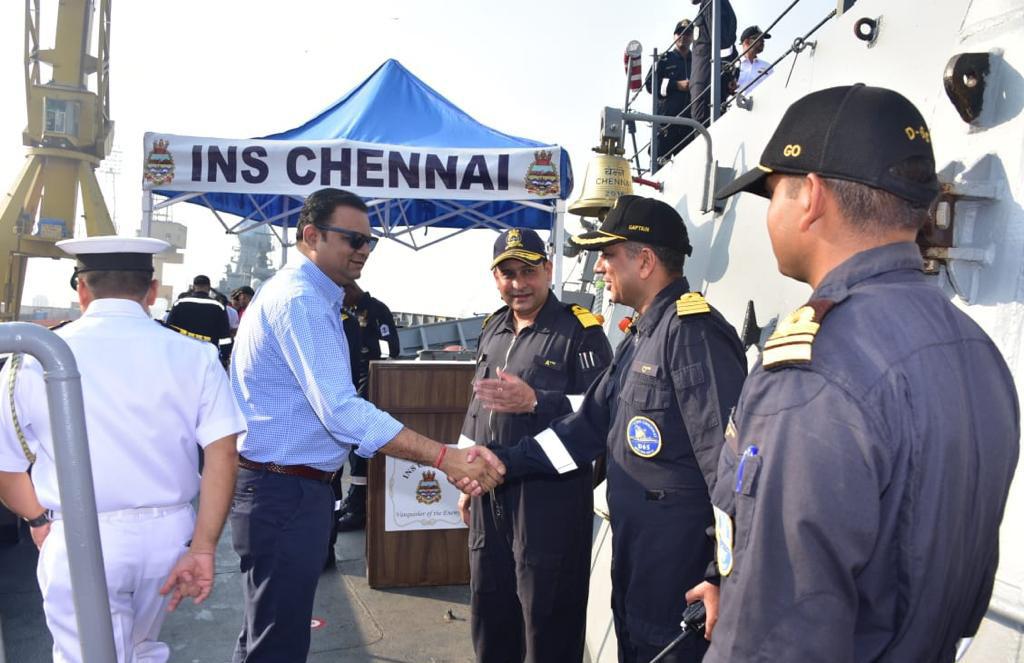
Highlights of the day included exercises such as simulated attack by Fast Attack Craft, an air power demonstration, search and rescue by Chetak helicopters, sonar dunk operation by a Sea King
helicopter, underway replenishment and personnel transfer at sea. To expose the dignitaries to all facets of naval operations at sea, a submarine demonstration was also conducted.
Hon’ble Speaker of Legislative Assembly, Adv. Rahul Narwekar and Hon’ble Minister, Shri Chandrakant Dada Patil were among dignitaries that embarked ships. Senior officials of the command interacted with all visiting dignitaries and provided them an overview of operations undertaken by the Indian Navy with emphasis on threats and challenges the nation faces in the maritime domain. The Day at Sea was intended to provide legislators and government officials an understanding of the crucial role the Navy plays in national security and nation-building, and expose them to the rigours and challenges of a life at sea.



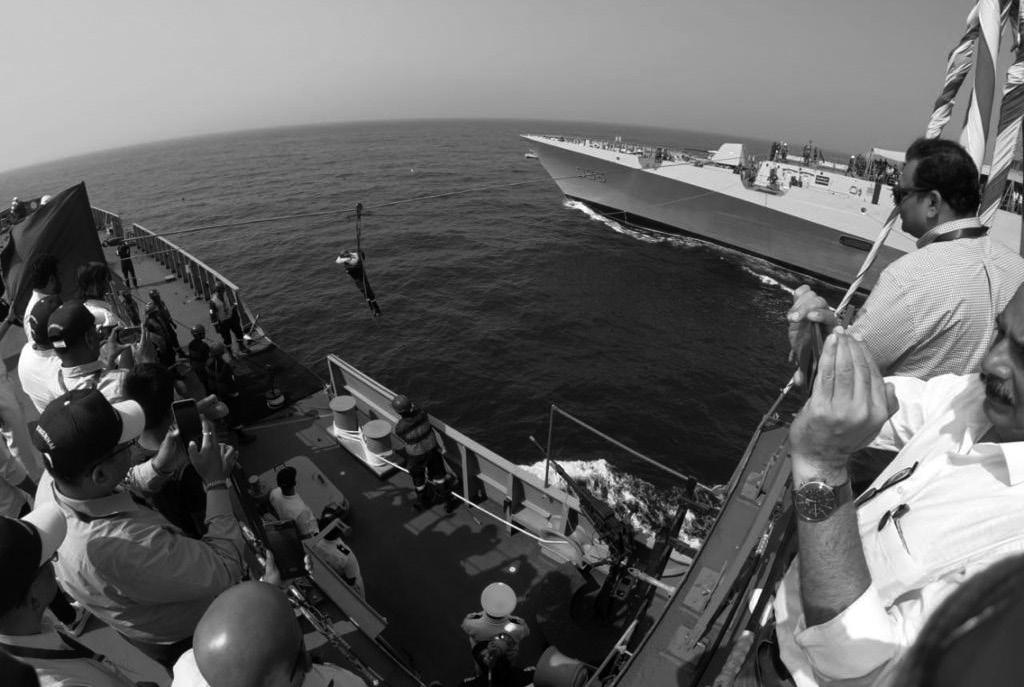
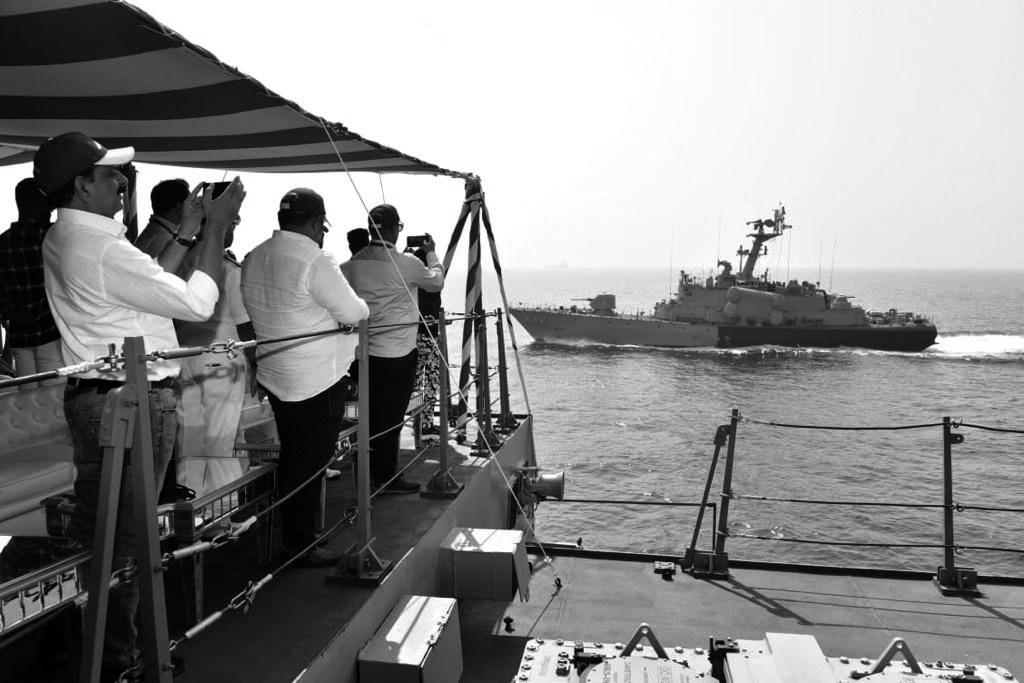

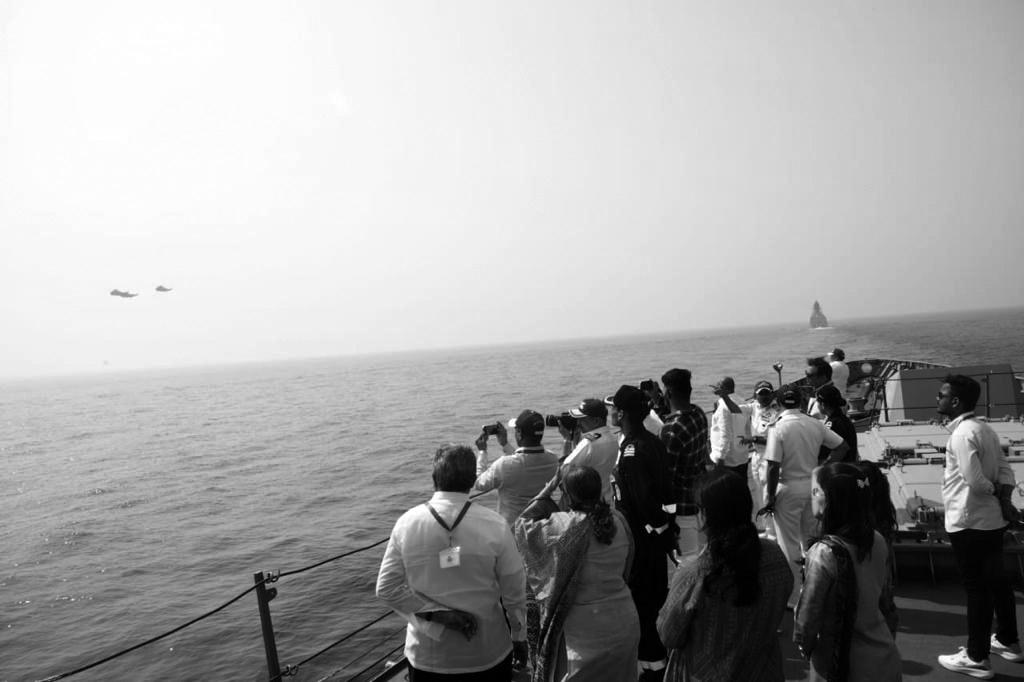
This year is crucial for the energy mix in European countries, as the EU has imposed new sanctions on Russia. It is important to emphasize that the EU sanctions against Russia do not affect the agricultural and food sectors. On November 14, the British Foreign Secretary, the High Representative of the European Union, and the U.S. Secretary of State issued a statement on global food security and Russia sanctions.
The sanctioned products with significant effects on maritime trade and freight rates include crude oil, refined petroleum products, coal, and steel. Following the adoption of the sixth sanctions package in June 2022, the restrictions will apply to crude oil from December 5, 2022, and to other refined petroleum products from February 5, 2023. Currently, there is an exemption for importing crude oil via pipelines for EU member states that rely on Russian supplies due to their geographical location without other alternatives.
There is a six-month transition period for seaborne crude oil for existing contracts and spot transactions to allow global markets to adjust, and an eight-month transition period for refined petroleum products. After a transitional period of eight months, member States importing Russian crude oil and petroleum products through pipelines cannot resell these products to other Member States or to third countries.
The coal was the first in the round of sanctions for the EU embargo on Russian coal, and the 120-day deadline for complying with the coal ban since it

was adopted in April expired Aug. 10. There is a three-month transition period for existing contracts signed before the export ban was enacted. The European Commission estimates that reducing Europe’s dependence on Russian coal could cost the Russian economy an annual loss of about $8 billion.
Meanwhile, European Union countries have already begun to reduce overall coal imports to meet climate goals and find clean alternatives. At the COP27 UN climate conference in Sharm el-Sheikh on November 4, the Commission called on all Parties to take urgent action to reduce greenhouse gas emissions and meet the commitments of the Paris Agreement and the Glasgow Climate Pact adopted last year at COP26. The transition to net-zero emissions will require innovative technologies such as carbon capture and storage to meet the EU’s commitment to reduce CO2 emissions by at least 55% by 2030 and become the world’s first carbon-neutral block by 2050, as envisioned by the European Green Deal.
This month’s analysis focuses on coal flows to Europe, the extent to which current trends reflect the impact of existing EU sanctions, and whether
there is currently a detour of coal flows from other destinations toward major European importing countries.


Using Signal Ocean data, we analyze recent trends in coal flows and the potential impact on demand growth as we confront ongoing geopolitical uncertainties and the challenges of the green transition to a net-zero future.
I. Coal flows to Europe from all over the world
An initial look at European coal imports (Figure 1) shows that total shipments have increased in the current year compared to the previous year, with the Russian Federation remaining the top source country and, the Netherlands the top destination country. Flows are expected to slow in the last quarter of the year, as the EU oil embargo on Russian coal has already curtailed supplies and other source countries are gradually replacing the volumes needed. October already ended with a lower monthly volume compared to the record high of August and September and the end of the first quarter of the year.
Today we are talking about replacing Russian coal flows to Europe, as we approach the middle of winter, and many European
countries are expected to burn more coal due to the energy crisis. It is incredible that South African coal exports to Europe have jumped this year, reaching spectacular annual growth. September ended with record monthly shipments (image 2), the highest this year, but the last three quarters also saw the most increased volumes compared to similar months in the previous two years.
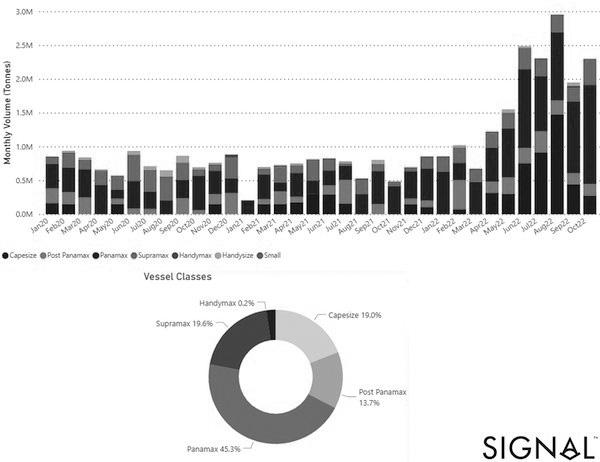
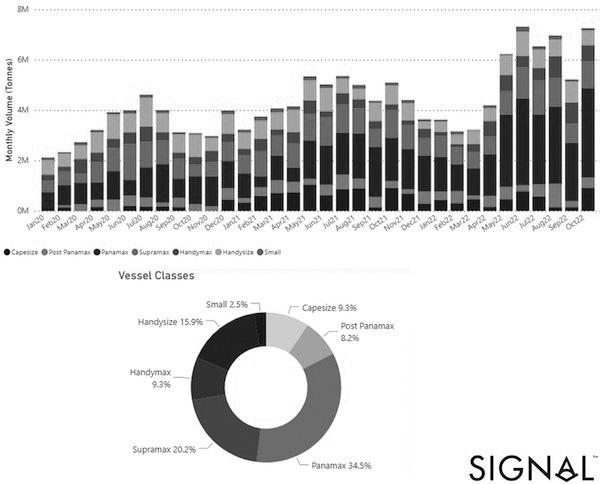
III. The Netherlands emerged as the top destination for US coal exports
We took a look at the Netherlands to examine how the main European coal importer from Russia is gradually switching to other primary sources to replace the Russian loss. As can be seen in image (3) below, the United States has been aggressively seeking to meet the energy needs of the
Netherlands. After the end of the second quarter of this year, Russian coal imports to the Netherlands fell to almost zero in September and October, while the United States increased its exports to the highest level in two years.
IV. Russian coal gains share in Asia: China and India
Russia appears to remain an important source of Chinese coal even after Australia’s export ban, but India has also increased its Russian coal imports at favorable prices. The Asian market is expected to absorb the lion’s share of Russian coal imports in the coming days as geopolitical tensions increase and the European Union is already in the process of reducing its dependence on coal and oil imports from Russia.
As shown in image 4, Russian coal shipments to China have increased significantly since April, except for a downward trend in September. October ended similarly strong to June and July before the enforcement of the EU coal import ban on Russia. Panamax vessels lead shipments with a 35% share, while Supramax vessels have caught up with a 20% share.

In the case of the Indian coal market (image 5), we have seen a historical record of Russian coal imports in the summer season. With a trend of decrease in the fall, however, the pace remains historically high and India appears to be dependent on Russian coal. The share of Panamax vessels in Russian coal imports for the Indian market is even more significant than that of the Chinese, at 45%, while the percentage of Supramax vessels is 20%, as in the case of China.
V. Demand – Ton Days and Miles Interestingly, the recent trend by China and India to
buy Russian coal at a discount led to an increase in ton-days and miles for Capesize vessels in October which exceeded the levels of a similar period in 2021 and 2020. However, there was a downward correction in November, but values still have not fallen below the records of the previous two years. It appears that Russia’s continued dominance in Asia for seaborne coal imports will support the increase in ton-days and miles for the larger vessel categories and trigger a new increase in Capesize freight rates.
As shown in the image (6) below, the fourth quarter began with a significant increase in ton-days and miles for Capesize vessels, and it remains to be seen how this trend will develop in the final days of the year.
What we will see in the coming days depends largely on the new trends in coal imports that have emerged following the enforcement of the EU ban on Russian coal, and how this will shift existing trade routes to new, longer routes for European and Asian importers to meet their energy needs. Overall, the first three quarters of the year have already shown that European coal imports are being replaced by Russian coal while emerging Asian coal markets will most likely play a key role in driving up freight rates for the larger vessel categories for the rest of this year and next.
Logistics forms the backbone of the Indian economy as it provides livelihood to more than 22 million people. In 2020, the global logistics market suffered a tremendous loss owing to the non-efficient chain in the municipal sphere. When it comes to India, there are three key sectors that experience the logistical backlash. They are agriculture, manufacturing, and services. India’s logistics sector has traditionally functioned inefficiently, and the numbers suggesting those are highly contradictory to its economic growth. The logistics sector in India is crucial for economic growth; however, to date, this sector has lagged behind the economy. Logistics includes within itself the strong warehousing and transportation of raw materials, CNG, LNG, petroleum, livestock, dry bulk cargo, food grains, and so on across different locations from one production zone to another.
Looking at the statistics, India’s logistics sector is far from achieving its full potential. There is a gap of US $180 billion per annum that needs to be covered if India wants to become a US $5 Trillion economy. The logistics sector alone generates a cost percentage of 13% to 14%, which is significantly high compared to the logistics cost in the US (9.5%), Japan (11%), and Germany (8%). India aims to bring down its cost percentage to less than 10% by 2022. The Federation of Indian Export Organisation (FIEO) believes that a reduction in the logistics cost by 10% will directly create a positive impact on the country’s export by about 5% to 8%. The core issue with the logistics sector is its highly fragmented, unautomated, unorganized, and complex departments. There are more than 20 government agencies, 40 Partner Government Agencies (PGA), 37 export promotion councils, 10000 commodities, 500 certifications, 160 billion market size. Further, involving a 12
million employment base, 200 shipping agencies, 129 ICDs, 36 logistics services, 168 CFSs, 50 IT ecosystems, banks, and insurance agencies with 81 authorities and 500 certificates are required for EXIM1. The lack of automation in the logistics sector has been causing poor productivity. It’s imperative to understand that India has been a capital deficit and labor-intensive country; therefore, it has been economical to invest less to deploy cheap labor than to invest more in expensive technology.
India was ranked 44th in the World Bank Logistics Performance Index in 2018, dropping from 35 in 2016 as it scored less in all 6 parameters, which are Customs Infrastructure Logistics Competence, Tracking & tracing, International Shipments, and Timeliness. To bolster the sector by strengthening its internal connection, the Government rolled out the ambitious PM Gati Shakti National Master Plan in 20212 . The objective of the policy was to create seamless multi-modal connectivity for the development of a world-class integrated infrastructure. The National Logistics Policy (NLP), launched on 17th September 2022, aims to minimize costs and uproot inefficiencies by digitizing the entire logistics sector. This will drive the cost-toGDP percentage to a unit figure by 2030. The NLP intends to reduce time and money in transport which will directly improve the competitiveness of Indian goods and services. The policy also aims to raise India’s position in the Logistics Performance Index such that it is among the top 25 countries by 2030. NLP has been prepared in active consultation with union ministers of road transport, railways, civil aviation, shipping, and 46 pertaining agencies. A Comprehensive Logistics Action Plan (CLAP) divided into the right key action areas was proposed for implementation of the
policy, which are (i) Integrated Digital Logistics Systems, (ii) Standardization of physical assets and benchmarking service quality standards, (iii) Logistics Human Resources Development and Capacity Building (iv) State Engagement (v) EXIM (Export-Import) Logistics (vi) Service Improvement framework (vii) Sectoral Plan for Efficient Logistics (viii) Facilitation of Development of Logistics Parks.
The Unified Logistics Interface Platform (ULIP)3, another new platform from the NLP, would consolidate all digital services relating to the transportation industry under a single gateway. It consists of three parts: Integration of data sources from ministries; Data sharing with private parties; Supply chain document standardization. The procedures become simpler, more efficient, and transparent when real-time data and information are combined under a single platform. EXIM logistics are made easier by the e-marketplace Ease of Logistics platform, which unites service providers and customers4. With the ability for exporters to post their needs, the new portal facilitates the methodical flow of container demand and connects exporters with logistic service providers.
A recent Deloitte-Assocham study identified that the Indian coastline and river network has historically remained underused, even though they can be more energy-efficient, eco-friendly, and can reduce logistics drastically. The cost for coastal shipping is Rs 0.15-0.2 per tonne-km compared to Rs 1.5 for railways and Ts 2.5 for the road. This alone could provide a huge potential to lower logistics costs in the economy by Rs 21,000 to 27,000 crore by 2025.
The national average turnaround time of vessels for dry bulk and containers is estimated as 5.7 days and 1.9 days, respectively. Ships normally have to wait longer, and their loading & unloading productivity is also low. Ports are labour-intensive, and machines are outdated and obsolete, slowing down the mechanization process. Navigation channels have extensive restrictions that do not allow bigger vessels to be berthed. Even the hinterland links to ports are insufficient. There are often delays in coordination between ports and customs authorities, causing further delays in the dispensation of documentation and goods. Portside constraints add up to the dwell time before both incoming and outgoing cargo is cleared.
A draft legislation is being prepared to promote the growth of the logistic sector, replacing the
Multimodal Transportation of Goods Act, 1993 (MMTG) with a National Logistics Efficiency and Advancement Predictability and Safety Act (NLEAPS). The development of the shipping logistics business is paused due to obsolete port infrastructure, non-use of digitalized methods, limited backup facilities like CFSs/warehouse, assembly, packing, non-expansion of container attack areas, transfer bays, rail transfer, less hinterland connectivity, restrictive custom procedure, and port-side constraint. Centre has initiated “Sagarmala” for the basic infrastructure of ports; however, with NLP, the logistics constraint alongside clogged chains in shipping will see a wide relaxation. The dire objective is to integrate only necessary departments, automate the sector with digitization, and clear all modes of logistics transport, simplifying the clustered sectors.
MMTNotes:
1 https://commerce.gov.in/press-releases/ national-logistics-policy-will-be-released-soonpolicy-to-create-a-single-window-e-logisticsmarket-will-generate-employment-and-make-msmescompetitive-nirmala-sitharaman/
2 https://www.india.gov.in/spotlight/pm-gati-shaktinational-master-plan-multi-modal-connectivity
3 Report of the Working Group on Logistics. pp. 1–3. Accessed 30 October. 2022
4 “Ease of logistics portal by FIEO.” Website by FIEO. Accessed 30 October. 2022.
5 Considering to Replace Multi-Modal Transportation of Goods Act with National Logistics Law: Commerce Ministry” – The Hindu, 4 July 2020


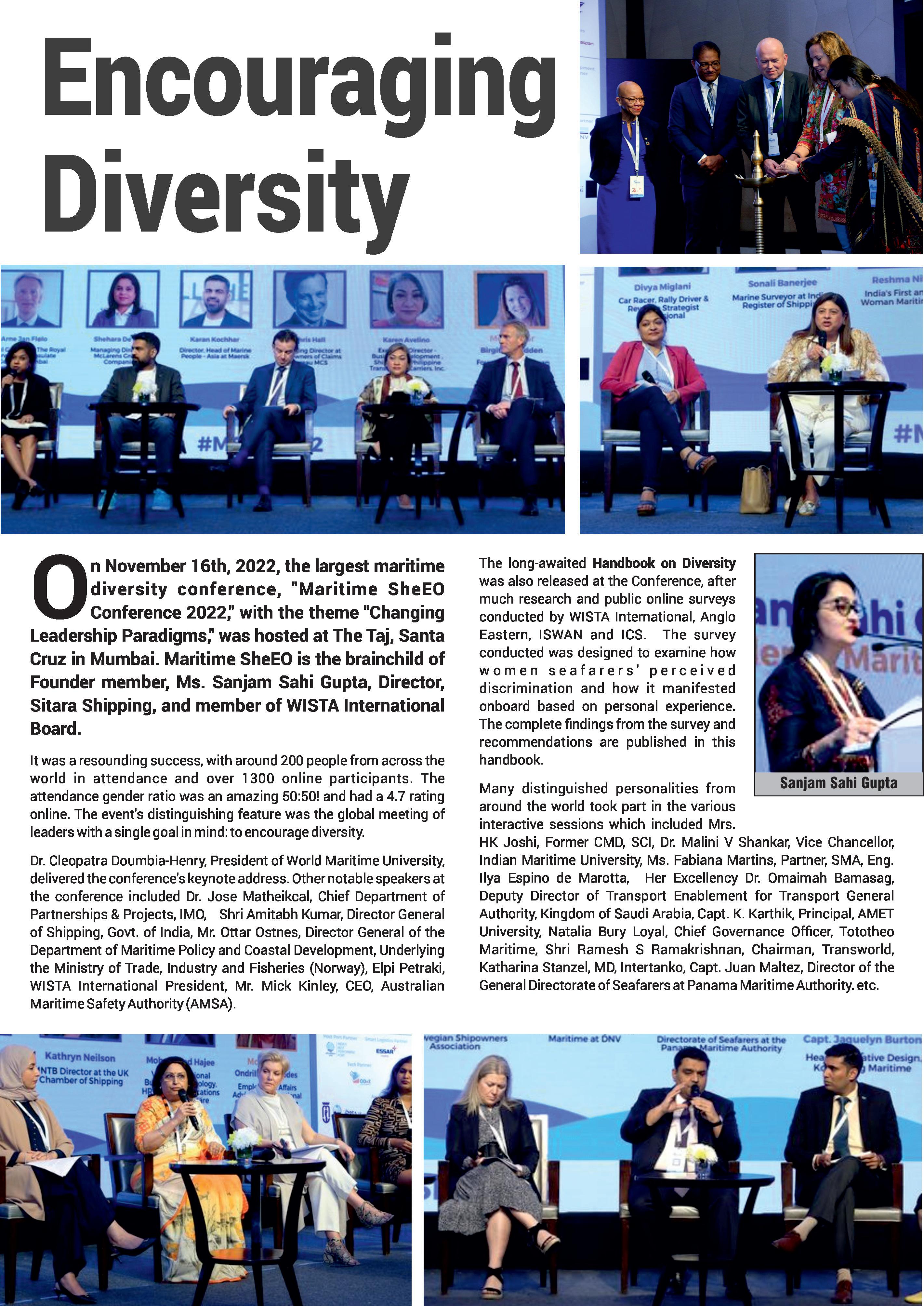
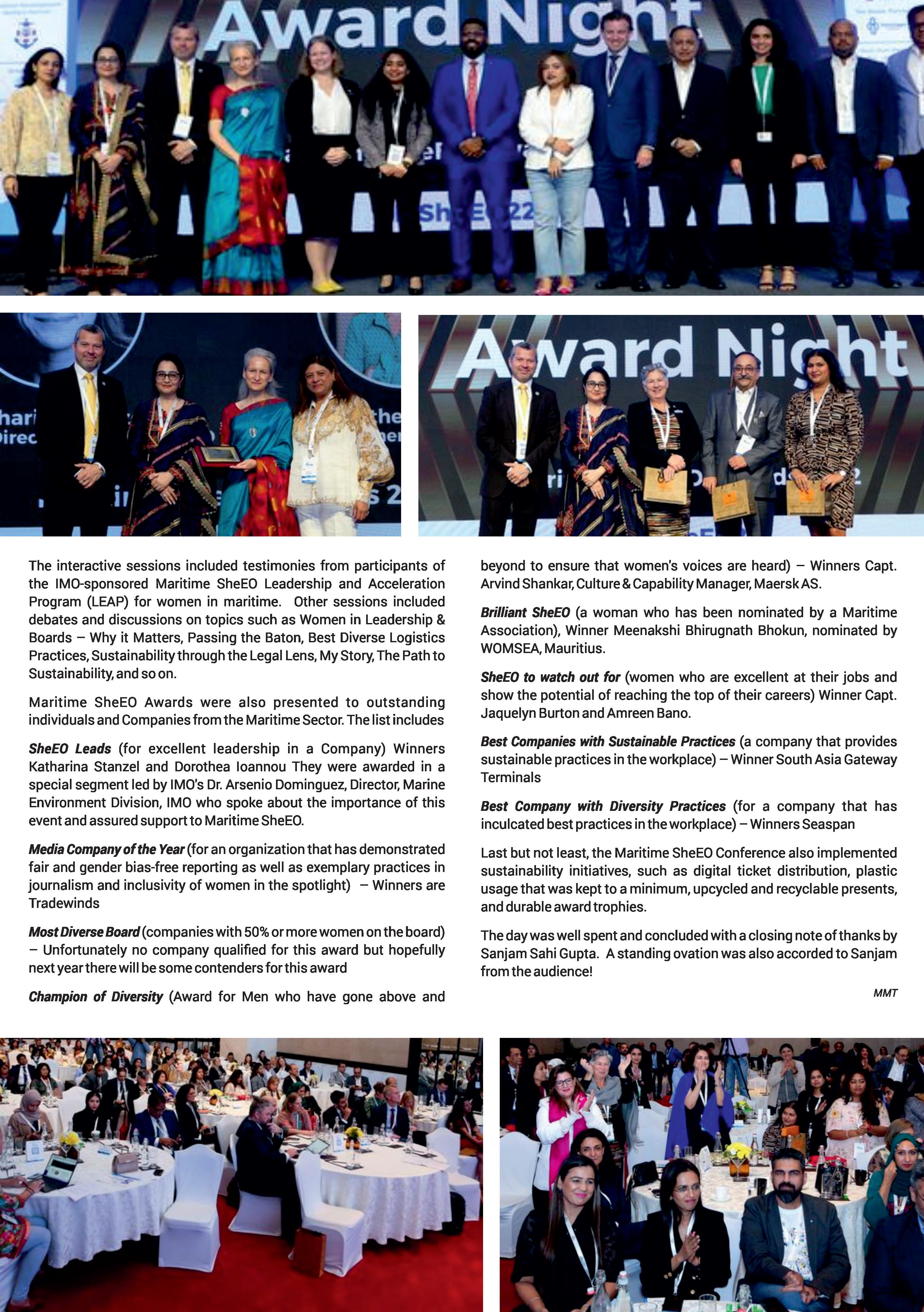
In recent years, shipping’s emissions have come under more scrutiny than ever before. COP26 was a standout event for shipping, where it featured high on the agenda, and discussions resulted in strong pledges from many attendees. This includes initiatives, such as the Clydebank Declaration, under which nations agreed to work together to support the establishment of green shipping corridors.
Now, the United Nations’ COP27 conference sees world leaders and global industries meet once again to discuss climate change. While shipping is less central on this year’s agenda than last year, at COP27 there is an array of side events focused on maritime decarbonisation and creating a safe and sustainable ocean economy, essentially working on the delivery of the pledges made and actions agreed last year. These conversations will likely centre around financing decarbonisation, the carbon market, as well as more stringent rules on emissions, such as methane slip.
Add to that the mounting pressure from customers for shipping companies to rapidly reduce their Greenhouse Gas (GHG) emissions, and the maritime industry is left with a prime opportunity to rapidly accelerate its energy transition.
Meanwhile, progress has been made towards balancing the trio of competing priorities of sustainability, security, and finance in the maritime industry. Some major maritime players are taking steps towards ensuring the industry meets full decarbonisation by 2050 in the safest, securest, and most sustainable way through collaborative initiatives including the Global Maritime Forum’s Getting to Zero Coalition and Poseidon Principles.
These projects – in which Wärtsilä is also involved – are spurring the development of future fuels, digital tools, and abatement technologies that can support the industry’s mission to a greener future. But there is still work to be done in developing shipping’s infrastructure and energy sources. So, what more can the industry do to achieve the ultimate challenge of maritime decarbonisation, and do it at an accelerated pace?

It has become increasingly understood that ship owners and operators need to act even more quickly if they are to meet the International Maritime Organization’s (IMO) 2030 and 2050 targets and support global climate goals. At the same time, they must do this while remaining profitable.
Without a single ‘silver bullet’ solution, pursuing a strategy of technological flexibility and working with partners that have platforms of systems that remain adaptable to new fuels and future regulations as they emerge is the only sensible course.
With the combination of deep domain expertise in power and propulsion solutions, voyage optimisation and digital technologies, as well as exhaust gas abatement and gas handling technologies, Wärtsilä is bursting with innovations and insight. All this greatly contributes towards the immense challenge and opportunity of decarbonising the shipping industry.

A major part of shipping’s decarbonisation journey will be the use of zero-carbon fuels, either on their own or blended with conventional fuels or alternative power sources. Steps can be taken today that unlock a wider range of fuel options and possibilities for the future.
As future fuel pathways are so complex and fleet compositions are so different, owners, charterers, and operators each need to find a bespoke way forward. One of the main ways the market is responding to this is via its growing demand for engines that can run on multiple different fuels.
Wärtsilä’s new W25 engine is a prime example of moving towards this concept. The engine is already capable of operating on diesel, LNG, or either gas or liquid carbonneutral biofuels, and can easily be upgraded to operate with future low or zero-carbon fuels as they become available.
Similarly, the Wärtsilä W46TS-DF, released earlier in 2022, features a modular design, which means every part of the engine can be replaced as needed. This approach
also makes it more cost-effective and straightforward to upgrade to run on carbon-neutral fuels, such as green methanol in the future.
We will also see the first Wärtsilä commercial newbuilding methanol engine in service in early 2023, which follows many full-scale engine tests that assess the optimum engine parameters for running on hydrogen and ammonia.
At the same time, biofuels can be a powerful emissions reduction solution, and will play a valuable role in lowering emissions without a capital-intensive fleet renewal or retrofitting in the short to medium term, particularly if they are deployed as blends. As a demonstration of dropin biofuel’s viability in the alternative fuels mix, the recent partnership with Holland America Line and GoodFuels saw sustainable biofuel deployed in Wärtsilä’s ZA40 engine onboard the Volendam to immediately reduce the vessel’s CO2, SOx and NOx emissions.
Wärtsilä is also pioneering solutions that will help to directly combat the biggest pollutant of them all – CO2 – via modular exhaust gas abatement technologies, and carbon capture and storage (CCS) innovations.
Exhaust treatment solutions helped to ensure compliance for ship owners and operators with IMO 2020 by reducing sulphur emissions. Now, based on experience in scaling this technology across shipping,
scrubbers can serve as the foundation from which other pollutants can be addressed.
Wärtsilä Exhaust Treatment has established a model where technologies can work together in the stack and throughout the exhaust chain. Thanks to their modularity, scrubbers form the foundation of a CCS solution for ships; a powerful tool that could enable owners and operators to make significant reductions in their Greenhouse Gas emissions for both existing and newbuild vessels.
In December 2021, a land-based CCS test unit was installed in Moss, Norway which has already shown promising results by capturing around 70% of CO2 emissions. The next stage of this ambitious journey is a pilot retrofit installation of our CCS system on onboard Solvang’s ethylene carrier Clipper Eos next year. This is a clear demonstration of the CCS technology’s commercial and technical viability to comply with environmental legislation and reduce shipping’s CO2 emissions.
Flexibility and modularity are key, which is why different configurations are available for CCS units and how the technology can be suitable for all ship types. The onboard storage of the captured CO2 can be achieved in different ways, e.g. by using deck tanks or container tanks.
By providing scrubber-enabled CCS technologies, ship owners and operators will be empowered to reduce emissions in the short and medium term before lowcarbon fuels emerge.
Digital technology – connecting the dots
Wärtsilä also recognises that digitalisation is a key piece of the decarbonisation puzzle. Wärtsilä provides cuttingedge digital technology to futureproof operations and enable the maritime industry to tackle the toughest global challenges. This includes helping the industry
to profitably decarbonise, which requires solutions that span the entire maritime ecosystem, from the engine room to the bridge, to the board room, and from ship to shore.
Wärtsilä’s portfolio of solutions ensure optimised operations, improving connection from sea to shore, helping shipping companies make the most of data, and supporting them in navigating the complex and changing regulatory environment. This empowers maritime stakeholders to achieve the sector’s emissions reduction targets and make tangible progress on evolving the way it operates.
The latest digital solution under Wärtsilä’s belt is its Fleet Optimisation Solution (FOS) – a holistic data analysis, voyage planning and performance management platform that can help maritime stakeholders run vessels and fleets with optimal safety, efficiency, and sustainability. FOS provides a central overview of a fleet and its performance, directly supporting users’ digitalisation goals and enabling their decarbonisation trajectories by creating optimisations today that can underpin future efficiency decisions, all based on the very best data analysis.

Wärtsilä forms strong and long-lasting partnerships with customers, supporting them throughout their ongoing digital journeys. This is just the beginning of that journey for many companies. Excitingly, collaborating on digitalisation now lays the groundwork for technologies that can have an even more profound future impact on efficiency, sustainability, and safety.
The need to reduce GHG emissions is an unprecedented challenge, but it is also an opportunity that requires collaboration. Everyone in the industry has an important role to play in supporting the energy transition in maritime, and Wärtsilä is ready to engage in building a brighter, decarbonised future for the maritime industry of tomorrow. Each vessel will require its own solutions, and Wärtsilä is providing a wide suite of solutions to support every ship owner’s pathway. It’s possible to start making progress today. What will your next step be on the energy transition journey.
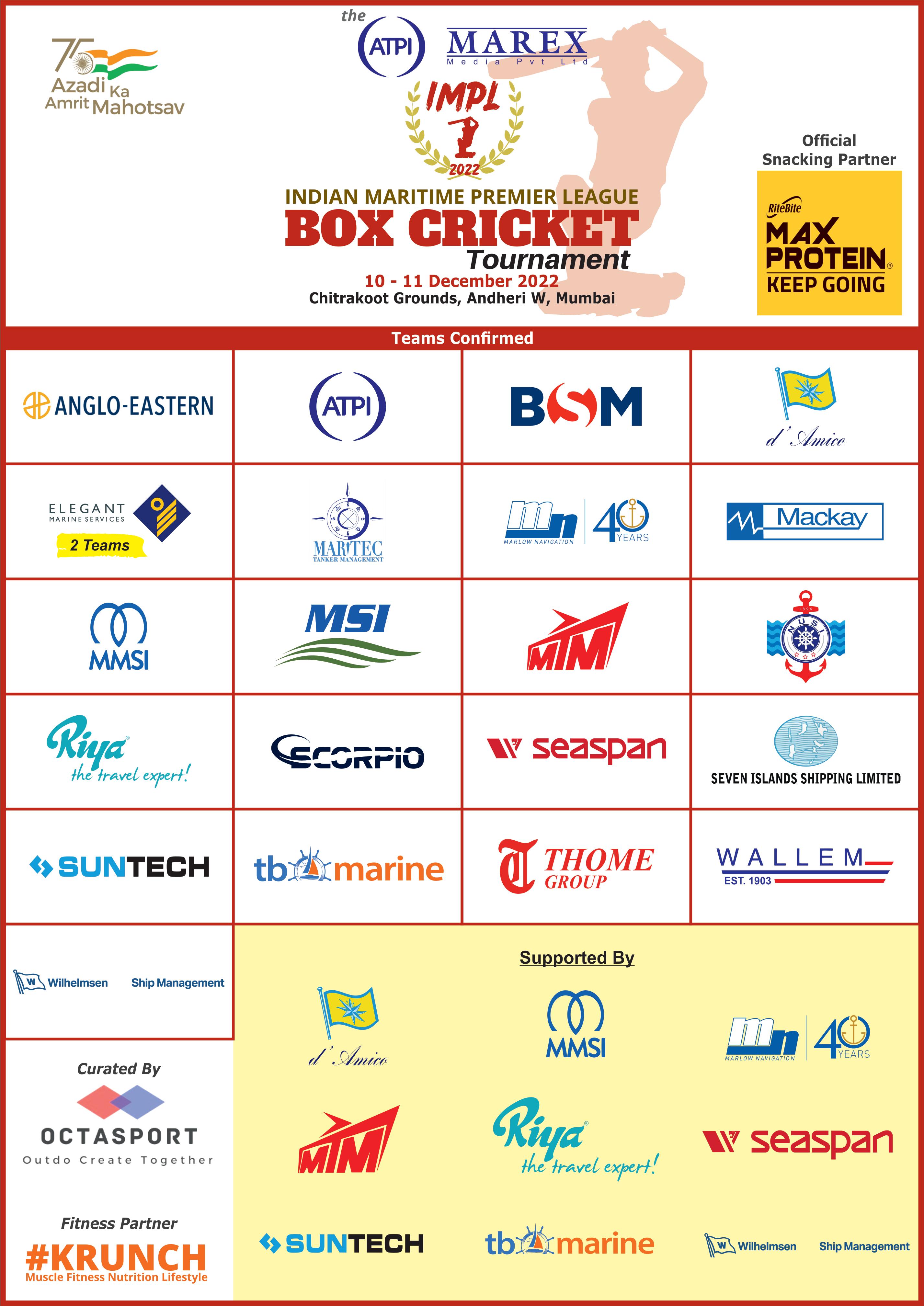


Our operational expertise in India is gained from over 35 years of answering the call for quality shipping and logistics services globally. We see every client as an individual and every job as unique - and we respond with quality, expertise, compliance as well as respect for you and the environment.
gac.com/india
For enquiries, contact us at india@gac.com
GAC Shipping (India) Private Limited Main office
GAC House, P.B. No. 515, Subramanian Road, Willingdon Island, Cochin 682 003, India
T: +91 484 266 8372
CIN: U63090KL1983PTC003733
Operating from branch offices across India: Bengaluru | Chennai | Dhamra | Goa | Haldia | Indore | Jamnagar | Kakinada | Kandla | Kochi | Kolkata | Krishnapatnam | Mangalore | Mumbai | Mundra | New Delhi | Nhava Sheva | Paradip | Pipavav | Port Blair | Pune | Surat | Tuticorin | Visakhapatnam
ATPI Marine & Energy is the leading global provider of specialist travel management to the shipping, offshore and energy industries. Our extensive knowledge and expertise is the reason why blue chip companies rely on us for their Mission Critical™ Travel. With consultants operating 24/7 in over 100 key locations, ATPI Marine & Energy consistently delivers a cost-effective, flexible and safety-focused service.

